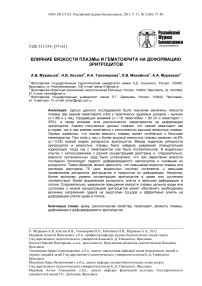Влияние вязкости плазмы и гематокрита на деформацию эритроцитов
Автор: Муравьев А.В., Кислов Н.В., Тихомирова И.А., Михайлов П.В., Муравьев А.А.
Журнал: Российский журнал биомеханики @journal-biomech
Статья в выпуске: 2 (60) т.17, 2013 года.
Бесплатный доступ
Целью данного исследования было изучение величины вязкости плазмы при разном гематокрите ( Hct ) у практически здоровых доноров – мужчин ( n = 48) и у лиц, страдающих анемией ( n = 18; гемоглобин > 90 г/л и гематокрит > 35%), а также влияние этих реологических характеристик на деформацию эритроцитов. Анализ полученных данных показал, что низкий гематокрит как в норме, так и при анемии сочетается с относительно высокой вязкостью плазмы. Однако оказалось, что низкая вязкость плазмы может сочетаться с большим гематокритом. При этом у лиц с более высокой вязкостью плазмы выявлен на 8% ( p The aim of this study was to investigate the value of the plasma viscosity (PV) under a different hematocrit (Hct) in healthy individuals and anemic patients and to analyze the effect of these rheological characteristics on the erythrocyte microrheological characteristics, mainly their deformation. In order to study the plasma viscosity role in circulation, the whole subject population of (48 normal individuals and 18 anemic patients) into two subgroups with the relative low and high level of PV was divided. The value of hematocrit (Hct) and red blood cell rigidity and deformability were considered under these conditions. The obtained data showed that low Hct both under the normal conditions and the anemia is accompanied by a relative high PV. It has been found that there was lower erythrocyte rigidity index (Tk) in individuals with high PV. There was a moderate negative correlation between the cell rigidity index and PV, whereas the correlation of this microrheological parameter with Hct was positive. Therefore, we can conclude that an increase of plasma viscosity brings into concord a decrease of erythrocyte rigidity and an erythrocyte deformability rise. On the other hand, it can suppose that the hematocrit increase leads to a rise of erythrocyte rigidity and their whole deformation reduction. Taken together, the obtained data have shown clearly that plasma viscosity increase under the conditions of low Hct ensures the needed shear stress on vascular endothelium and contribute heavily to the erythrocyte deformation. Taken together, the obtained data make us believe that the moderate plasma viscosity increase leads to activation of vascular control mechanisms and creation of more effective erythrocyte deformation. Therefore, the tissue perfusion and oxygen transport efficiency under these conditions can be improved.
Кровь, реологические свойства, гематокрит, вязкость плазмы, деформация и деформируемость эритроцитов
Короткий адрес: https://sciup.org/146216098
IDR: 146216098 | УДК: 531/534:
Текст научной статьи Влияние вязкости плазмы и гематокрита на деформацию эритроцитов
Принято считать, что снижение вязкости крови является фактором, обеспечивающим повышение ее текучести и улучшение перфузии тканей [6, 9, 11, 15]. Ведущая роль в этом изменении текучести цельной крови отводится концентрации эритроцитов (гематокрит) и вязкости плазмы [2–5, 7, 14, 20]. Эти реологические характеристики крови влияют на потоковую деформацию эритроцитов, поскольку через плазму и клетки передается деформирующая сила, созданная сердцем [1]. Эффект передачи зависит от плотности и вязкости среды, в которой находятся эритроциты, и от того, насколько плотно они «упакованы» в суспензии, т.е. от величины гематокрита [12, 13]. Однако сами клетки, обладая разной эластичностью, могут под влиянием одинаковых сил в разной степени изменять свою форму, т.е. деформироваться [3, 8, 14, 18].
Недавно было показано, что умеренное повышение вязкости плазмы, а следовательно, и вязкости цельной крови, благоприятно сказывается на перфузии тканей, способствует увеличению плотности функционирующих капилляров в них и снижению периферического сосудистого сопротивления [16, 17]. Последнее объясняется тем, что достаточно высокая вязкость плазмы способствует повышению напряжения сдвига на стенке сосуда. Это ведет к активации эндотелия с последующим выделением вазодилататорной молекулы – оксида азота (NO) [10, 15, 21]. Следовательно, артериолы участвуют в регуляции кровотока благодаря тому, что в их стенку «вмонтированы» сенсорные механизмы, способные регистрировать изменение напряжения сдвига на сосудистом эндотелии, созданного движущейся по сосуду кровью, обладающей эффективной вязкостью [19]. Кроме того, важное значение имеет и другой реологический аспект: более высокая вязкость плазмы способствует эффективной деформации клеток крови в потоке [13, 16].
С учетом вышесказанного было проведено исследование разных соотношений вязкости плазмы и гематокрита в цельной крови и их влияние на деформацию эритроцитов.
Материал и методы исследования
Кровь для анализов получали венопункцией у практически здоровых доноров – мужчин ( n = 48) и у лиц, страдающих анемией ( n = 18; гемоглобин > 90 г/л и гематокрит > 35%). Для исследования микрореологических свойств эритроцитов их, после отделения от плазмы, отмывали трехкратным центрифугированием в изотоническом растворе (NaCl).
Для оценки вклада вязкости плазмы из общего числа обследованных лиц (норма и анемия) были выделены подгруппы с относительно высокой величиной этой реологической характеристики крови, и ее величину сопоставляли с уровнем гематокрита в этих условиях.
Для уточнения роли вязкости плазмы в изменениях деформации эритроцитов было проведено исследование на их суспензиях ( Hct = 40%) с заменой плазмы на стандартные растворы декстрана c молекулярной массой 70 килодальтон (декстран 70). В исследовании были использованы три концентрации декстрана 10; 20 и 30 г/л, с вязкостью 1,36; 1,66 и 2,08 мПа∙с соответственно. Вязкость цельной крови, плазмы и суспензий эритроцитов измеряли на полуавтоматическом капиллярном вискозиметре при шести напряжениях сдвига (0,20–2,00 Н ∙ м–2). Оценку деформируемости эритроцитов проводили путем измерения индекса удлинения эритроцитов (ИУЭ) [4] и вязкости суспензий эритроцитов. Для анализа вклада вязкости плазмы и гематокрита в изменение деформации эритроцитов рассчитывали индекс их ригидности [11] по следующей формуле:
Tk= (ηr0,4–1) (ηr0,4⋅Hсt), где ηr – относительная вязкость крови (вязкость крови / вязкость плазмы); Hсt – гематокрит, выраженный в долях от единицы. Таким образом, в расчет индекса Tk входит величина вязкости плазмы
ηr=ηb, ηp где ηb – вязкость цельной крови; ηp – вязкость плазмы и гематокрит (Hct).
Определение гематокрита цельной крови и суспензий эритроцитов в растворах декстрана 70 проводили на микрогематокритной центрифуге СМ–70 (Латвия).
Статистическую обработку полученных цифровых материалов и все виды анализа результатов, включая корреляционный и регрессионный, проводили, используя табличный редактор Microsoft Excel .
Результаты исследования
Анализ полученных данных показал, что, с одной стороны, низкая концентрация эритроцитов сочетается с относительно высокой вязкостью плазмы (табл. 1). С другой стороны, оказалось, что низкая вязкость плазмы может сочетаться с большим гематокритом (табл. 2). При этом важно заметить, что в подгруппе лиц с более высокой вязкостью плазмы (в среднем 1,91 ± 0,01 мПа ⋅ с) наблюдали самый низкий индекс ригидности эритроцитов ( Tk = 0,622 ± 0,013). При увеличении концентрации эритроцитов в крови наблюдается тенденция к приросту их индекса ригидности ( Tk ). Тогда как более высокой вязкости плазмы соответствует меньшее значение Tk (рис. 1).
Разница в величине вязкости растворов декстрана и контрольного раствора (изотонический раствор NaCl) составила: 1) между 1%-ным раствором декстрана 70 и контролем – 29%; 2) между 2%-ным раствором декстрана 70 и контролем – 58%; 3) между 3%-ным раствором и контролем – 96% (табл. 3).
Как видно из данных, приведенных в табл. 4, прирост вязкости суспензии эритроцитов, при увеличении вязкости суспензионной среды, сопровождался уменьшением индекса ригидности эритроцитов.
Таблица 1
Реологические показатели крови в группах здоровых лиц с разным уровнем гематокрита ( M ± m ; n = 48)
|
Показатели |
Низкий Hct ( n = 16) |
Нормальный Hct ( n = 16) |
Высокий Hct ( n = 16) |
|
Hct , % |
36,0 ± 0,4* |
43,0 ± 0,4 |
52,5 ± 0,6* |
|
ВК, мПа ⋅ с |
3,80 ± 0,10** |
4,10 ± 0,10 |
5,40 ± 0,30* |
|
ВП, мПа ⋅ с |
1,90 ± 0,01** |
1,74 ± 0,02 |
1,88 ± 0,03** |
|
Tk , отн. ед. |
0,636 ± 0,015 |
0,644 ± 0,014 |
0,777 ± 0,010 |
Примечания: * – различия достоверны при p < 0,01; ** – различия достоверны при р < 0,05 относительно нормального Hct ; Hct – гематокрит; ВК – вязкость крови при высокой скорости сдвига ( γ > 200 c–1); ВП – вязкость плазмы; Tk – индекс ригидности эритроцитов.
Таблица 2
Реологические показатели крови в группах здоровых лиц с разной величиной вязкости плазмы ( M ± m ; n = 48)
|
Показатели |
Низкая вязкость плазмы ( n = 16) |
Нормальная вязкость плазмы ( n = 18) |
Высокая вязкость плазмы ( n = 14) |
|
ВП, мПа ⋅ с |
1,72 ± 0,012 |
1,80 ± 0,006* |
1,91 ± 0,010* |
|
ВК, мПа ⋅ с |
4,06 ± 0,13 |
4,08 ± 0,13 |
4,32 ± 0,17 |
|
Hct , % |
43,50 ± 0,66 |
40,63 ± 0,98** |
41,40 ± 0,74 |
|
Тk , отн. ед. |
0,672 ± 0,002 |
0,681 ± 0,015 |
0,622 ± 0,013* |
Примечания: * – различия достоверны при p < 0,01; ** – различия достоверны при р < 0,05 относительно нормальных значений вязкости плазмы; Hct – гематокрит; ВК – вязкость крови при высокой скорости сдвига ( γ > 200 c–1); ВП – вязкость плазмы; Tk – индекс ригидности эритроцитов.
0,90


0,80
0,70
0,60
0,50
0,40
0,30
0,20
0,10
0,00
0,80
0,70
0,60
0,50
0,40
0,30
0,20
0,10
0,00
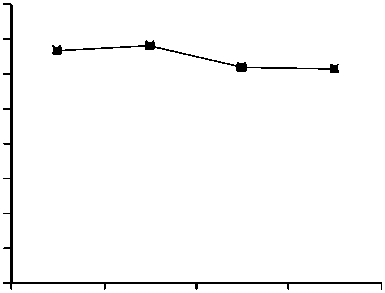
12 3 4
а
б
Рис. 1. Изменения индекса ригидности эритроцитов ( Tk ) при четырех разных уровнях: а – гематокрита (отн. единицы); б – вязкости плазмы (отн. единицы)
Таблица 3
Вязкости суспензионных сред (в мПа^с) при температуре 20,0 оС
|
Суспензионные среды |
Вязкость суспензионной среды, мПа∙с |
|
Изотонический раствор (контроль), (0,9% NaCl) |
1,05 |
|
Декстран 70 (1%) |
1,36 |
|
Декстран 70 (2%) |
1,66 |
|
Декстран 70 (3%) |
2,06 |
Таблица 4
Реологические показатели суспензий эритроцитов с Hct = 40% в суспензионных средах разной вязкости ( M ± m ; n = 16)
|
Показатели |
Контроль |
Декстран 70 (1%) |
Декстран 70 (2%) |
Декстран 70 (3%) |
|
С , мПа. с |
4,062 ± 0,078 |
4,893 ± 0,137* |
5,634 ± 0,177** |
6,486 ± 0,214** |
|
Тк , отн. ед. |
0,418 ± 0,004 |
0,400 ± 0,007* |
0,386 ± 0,007** |
0,366 ± 0,008** |
|
ИУЭ, отн. ед. |
0,214 ± 0,006 |
0,227 ± 0,005 |
0,235 ± 0,005* |
0,238 ± 0,006* |
Примечания: * - различия достоверны при р < 0,05 относительно контроля; ** -различия достоверны при p < 0,01 относительно контроля; ВС - вязкость суспензии эритроцитов в декстране 70 при высоком напряжении сдвига; Tk - индекс ригидности эритроцитов; ИУЭ - индекс удлинения эритроцитов.
0,24
2,8
2,7
2,6
g 2,5
2,4
2,3
2,2
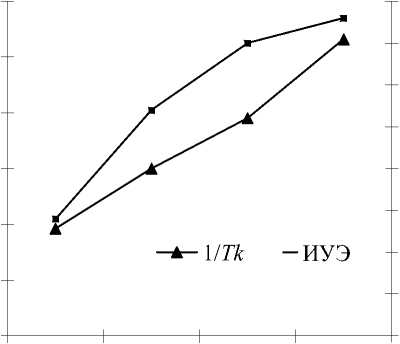
12 3 4
0,24 0,23
0,23 §
0,22 §
0,22 g
S 0,21
0,21 0,20
Рис. 2. Изменение индекса удлинения эритроцитов (ИУЭ) и показателя их эластичности (1/ Tk ) при повышении вязкости суспензионной среды: 1 - изотонический раствор NaCl (контроль); 2 - 1%-ный раствор декстрана 70;
3 - 2%-ный раствор декстрана 70; 4 - 3%-ный раствор декстрана 70
При анализе изменений собственной деформируемости эритроцитов (на основе индекса удлинения эритроцитов) было установлено, что при нарастании вязкости суспензионной среды происходит прирост этой механической характеристики клеток (рис. 2). Он был сходным с изменением показателя эластичности эритроцитов (величина обратная индексу ригидности [11]). Изменение последнего при повышении вязкости суспензионной среды хорошо описывается уравнением линейной регрессии (у = 0,11 x + 2,28; при достоверности аппроксимации данных R 2 = 0,992).
Если взять для сравнения отдельно тренды изменений этих двух характеристик микрореологии эритроцитов, то видно, что они очень сходны (рис. 3). Следовательно, обе характеристики хорошо выявляют степень деформируемости эритроцитов и их деформацию в целом.
2,8
2,7
2,6
Ь: 2,5
2,4
2,3
2,2
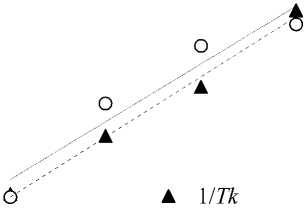
о ИУЭ
0,25 0,24 0,24 0,23
0,23 0,22 0,22 0,21
0,21 0,20
Рис. 3. Тренды (линейные регрессионные соотношения) изменений показателя эластичности (1/ Tk ) и индекса удлинения эритроцитов (ИУЭ) при повышении вязкости суспензионной среды: 1 – изотонический раствор NaCl (контроль); 2 – 1%-ный раствор декстрана 70; 3 – 2%-ный раствор декстрана 70; 4 – 3%-ный раствор декстрана 70; ИУЭ – индекс удлинения эритроцитов; 1/ Tk – показатель эластичности эритроцитов
Обсуждение результатов
При течении крови в крупных и мелких сосудах эритроциты подвергаются деформации [1, 2]. При анализе этой механической характеристики клеток крови необходимо выделить группу внешних деформирующих факторов (давление, вязкость плазмы и гематокрит (рис. 4)). При этом важно иметь в виду, что сами клетки обладают разной способностью поддаваться действию деформирующих сил, т.е. они обладают деформируемостью, которая зависит от вязкоэластичности плазматической мембраны, цитоплазматической вязкости и формы клеток [2, 7, 12, 14]. Давление крови представляет собой силу, которая создает напряжение на мембране эритроцитов и деформирует их [1, 2, 8]. Это напряжение передается через жидкость – плазму, которая обладает вязкостью и плотностью [1]. Известно, что более высокая вязкость среды способствует более эффективной передаче деформирующей силы на плазматическую мембрану клетки [12, 13]. Разная степень концентрации эритроцитов тоже может влиять на эффект передачи деформирующего усилия от одной клетки к другой [3, 11].
Результаты исследования свидетельствуют о том, что при снижении концентрации эритроцитов и, следовательно, при изменении условий передачи деформирующей силы на эритроциты более высокая вязкость плазмы (или суспензионной жидкости – раствора декстрана 70), вероятно, может компенсировать ослабление эффекта гематокрита (рис. 5).
Существенная роль умеренно повышенной вязкости плазмы подтвердилась при исследовании соотношения гематокрита и вязкости плазмы у лиц с анемией. Так, было установлено, что самые низкие значения гематокрита (24,2 ± 0,49%) сочетаются с более высокой вязкостью плазмы (2,20 ± 0,06 мПа∙с) и наоборот: при относительно высоком гематокрите (34,0 ± 0,90%) была зарегистрирована более низкая вязкость плазмы (рис. 6). При этом в подгруппе с высокой вязкостью плазмы индекс ригидности эритроцитов оказался на 20% ( p < 0,05) ниже, чем в среднем по группе лиц c анемией.
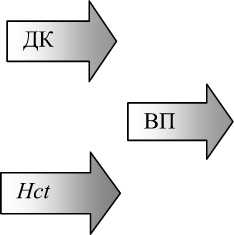
а
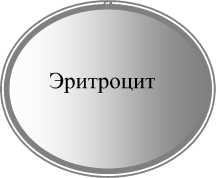
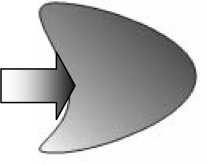
Деформация эритроцита
б
Рис. 4. Схема взаимодействия внешних и внутренних факторов деформации эритроцитов: а – внешние факторы деформации эритроцитов (давление крови, вязкость плазмы, гематокрит); б – внутренние факторы деформации эритроцитов (вязкоэластичность мембран, цитоплазматическая вязкость, форма клеток)
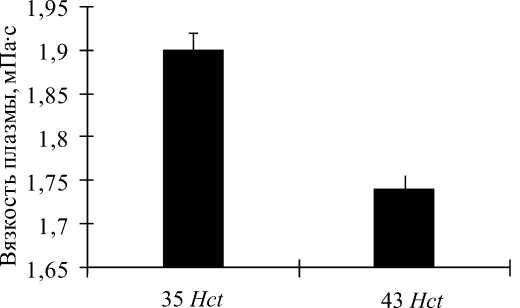
Рис. 5. Соотношение низкого и нормального гематокрита и вязкости плазмы (здоровые лица)
2,3
2,25
9 2,2
cd ’
2,15
2,1
2,0,5
cd
Б 2
к н 1,95
s 1,9
co , oc

* р < 0,05; относительно нормального Hct

34 Hct
24,2 Hct
Рис. 6. Соотношение величин гематокрита и вязкости плазмы при анемии: * p < 0,05; относительно Hct
Была выявлена умеренная отрицательная корреляция между индексом ригидности эритроцитов и вязкостью плазмы ( r = – 0,490), тогда как с гематокритом индекс Tk коррелировал положительно ( r = 0,640). Таким образом, можно полагать, что повышение вязкости плазмы приводит к приросту деформации эритроцитов. ISSN 1812-5123. Российский журнал биомеханики. 2013. Т. 17, № 2 (60): 75–83 81
Тогда как при увеличении гематокрита, напротив, наблюдается увеличение индекса Tk эритроцитов и уменьшение их деформации [9, 11].
Полученные результаты исследования основных реологических характеристик крови, оказывающих регуляторное влияние на перфузию тканей и доставку в них кислорода, свидетельствуют о компенсаторном повышении вязкости плазмы в условиях гемодилюции. При невозможности увеличить кислородную емкость крови при низком гематокрите и гемоглобине (в условиях анемии) повышение вязкости плазмы может оптимизировать сдвиговое напряжение на эндотелии сосудов [10, 15]. Последнее включает микрососудистый регуляторный механизм с участием оксида азота [17]. Как следует из анализа полученных результатов, прирост вязкости плазмы умеренно сочетается с более эффективной деформацией эритроцитов. Следовательно, перфузия тканей и доставка кислорода в тканевые микрорайоны в этих условиях может быть улучшена.
Выводы
-
1. Повышение вязкости плазмы цельной крови или суспензионной среды клеток с декстраном 70 сочетается с уменьшением ригидности эритроцитов и приростом их деформации в потоке.
-
2. Для более высокого уровня концентрации эритроцитов цельной крови или приготовленной суспензии характерна выраженная ригидность клеток и меньшая деформация в потоке.
-
3. Умеренное повышение вязкости плазмы и цельной крови в условиях низкой концентрации эритроцитов может обеспечить необходимую величину напряжения сдвига на эндотелии сосудов, оптимальную перфузию тканей и эффективно влиять на деформацию клеток крови в потоке.
Благодарность
Исследование выполнено при поддержке Министерства образования и науки Российской Федерации, соглашение 14.B37.21.0214, и при поддержке РФФИ, грант № 12-04-00550-а.
82 ISSN 1812-5123. Российский журнал биомеханики. 2013. Т. 17, № 2 (60): 75–83
Список литературы Влияние вязкости плазмы и гематокрита на деформацию эритроцитов
- Каро К., Педли Т., Шротер Р., Сид У. Механика кровообращения. -М.: Мир, 1981. -623 с.
- Левтов В.А., Регирер С.А., Шадрина Н.Х. Реология крови. -М.: Медицина, 1982. -272 с.
- Муравьев А.В. Чепоров С.В. Гемореология (экспериментальные и клинические аспекты реологии крови). -Ярославль: Изд-во Ярослав. гос. пед. ун-та им. К.Д. Ушинского, 2009. -178 с.
- Муравьев А.В., Тихомирова И.А., Михайлов П.В., Маймистова А.А. Муравьев А.А., Роль микрореологических свойств эритроцитов в неньютоновском поведении цельной крови//Российский журнал биомеханики. -2010. -Т. 14, № 4 (50). -С. 96-104.
- Муравьев А.В., Тихомирова И.А., Булаева С.В., Вдовин В.А., Муравьев А.А. Исследование роли отдельных реологических характеристик крови в изменении ее текучести и транспортного потенциала//Российский журнал биомеханики. -2012. -Т. 16, № 3 (50). -С. 32-41.
- Чернух А.М., Александров П.Н., Алексеев О.В. Микроциркуляция. -М.: Медицина, 1984. -432 с.
- Ajmani R.S. Hypertension and hemorheology//Clin. Hemorheol. Microcirc. -1997. -Vol. 17, No. 6. -P. 397-420.
- Baskurt O.K., Meiselman H.J. Blood rheology and hemodynamics//Semin. Thromb. Hemost. -2003. -Vol. 29. -P. 435-450.
- Brun J.F., Micallef J.F., Supparo I., Rama D., Benezis C., Orsetti A. Maximal oxygen uptake and lactate thresholds during exercise are related to blood viscosity and erythrocyte aggregation in professional football players//Clin. Hemorheol. -1995. -Vol. 15. -P. 201-212.
- Cabrales M., Tsai A.G. Plasma viscosity regulates systemic and microvascular perfusion during extreme anemic conditions//Am. J. Physiol. -2006. -Vol. 291. -H2445-H2452.
- Dintenfass L. Clinical applications of heamorheology/The Rheology of blood, blood vessels and associated tissues. -New York: Oxford Press, 1981. -P. 22-50.
- Kon K., Maeda N., Shiga T. The relationship between deoxygenation rate erythrocytes and deformation by shear stress//Biorheology. -1983. -Vol. 20. -P. 92-100.
- Kon K., Maeda N., Shiga T. Erythrocyte deformation in shear flow: influences of internal viscosity, membrane stiffness, and hematocrit//Blood. -1987. -Vol. 69. -P. 727.
- London M. The role of blood rheology in regulating blood pressure//Clin. Hemorheol. and Microcirc. -1997. -Vol. 17. -P. 93-106.
- Martini J., Carpentier B., Chávez Negrete A., Cabrales P., Tsai A.G., Intaglietta M. Beneficial effects due to increasing blood and plasma viscosity//Clin. Hemorheol. and Microcirc. -2006. -Vol. 35, № 1, 2. -P. 51-57.
- Popel A.S., Johnson P.C. Microcirculation and Hemorheology//Annu. Rev. Fluid Mech. -2005. -Vol. 1 (37). -P. 43-69.
- Salazar Vázquez B.Y., Martini J., Chávez Negrete A., Tsai A.G., Forconi S., Cabrales P., Johnson P.C., Intaglietta M. Cardiovascular benefits in moderate increases of blood and plasma viscosity surpass those associated with lowering viscosity: Experimental and clinical evidence//Clin. Hemorheol. Microcirc. -2010. -Vol. 2 (44). -P. 75-85.
- Stuart J., Nash G.B. Red cell deformability and haematological disorders//Blood Rev. -1990. -Vol. 4, No. 3. -P. 141-147.
- Sriram K., Salazar Vázquez B.Y., Tsai A.G., Cabrales P., Intaglietta M., Tartakovsky D.M. Autoregulation and mechanotransduction control the arteriolar response to small changes in hematocrit//Am. J. Physiol. Heart Circ. Physiol. -2012. -Vol. 303, No. 9. -H1096-H1106.
- Stoltz J.F., Donner M., Muller S., Larcan A. Hemorheology in clinical practice. Introduction to the notion of hemorheologic profile//J. Mal. Vasc. -1991. -Vol. 6. -P. 261-270.
- Tsai A.G., Nance P.R., Cabrales P. Frangos J.A., Buerk D.G., Intaglietta M.//Am. J. Physiol. -2005. -Vol. 288. -H1730-H1739.

